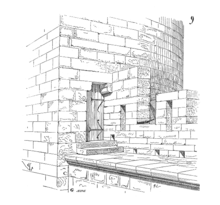Chemin de ronde
A chemin de ronde (French, "round path"' or "patrol path"; French pronunciation: [ʃəmɛ̃ də ʁɔ̃d]), also called an allure, alure or, more prosaically, a wall-walk, is a raised protected walkway behind a castle battlement.[1][2]

Chemin de ronde on a curtain wall. Access is given to the battlements and shooting slots in the parapet as well as to a tower door.
In early fortifications, high castle walls were difficult to defend from the ground. The chemin de ronde was devised as a walkway allowing defenders to patrol the tops of ramparts, protected from the outside by the battlements or a parapet, placing them in an advantageous position for shooting or dropping.
References
- Philippe Contamine (1986). War in the Middle Ages. Wiley-Blackwell. p. 107. ISBN 978-0-631-14469-4.
- J. E. Kaufmann; H. W. Kaufmann; Robert M. Jurga (2004). The medieval fortress: castles, forts and walled cities of the Middle Ages. Da Capo Press. p. 306. ISBN 978-0-306-81358-0.
This article is issued from Wikipedia. The text is licensed under Creative Commons - Attribution - Sharealike. Additional terms may apply for the media files.